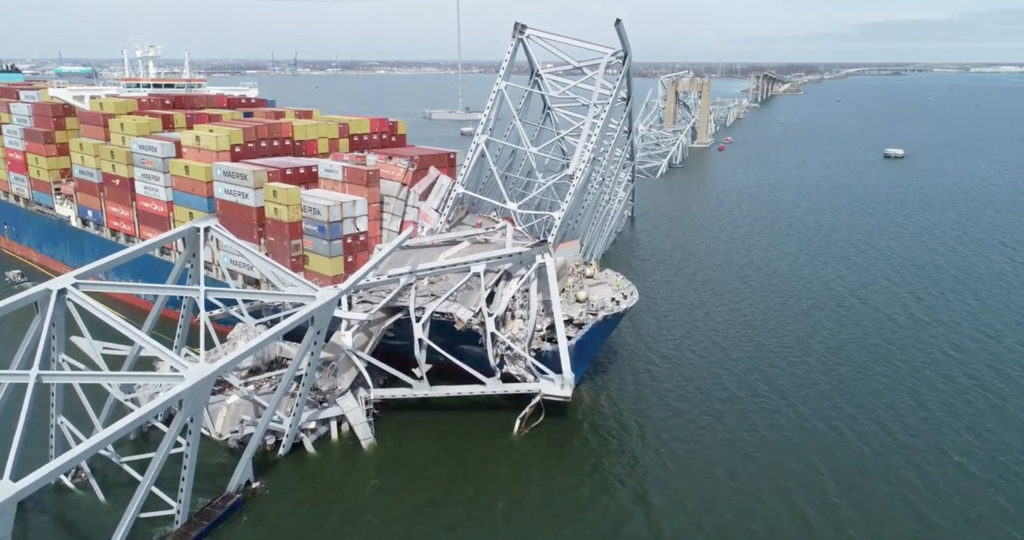
Like many of you I was surprised to wake up on Tuesday and to the news that a container ship Dali had lost power and subsequently collided with the Francis Scott Key Bridge in Baltimore causing it to collapse and claiming the life of 6 construction workers who were working on the bridge.
As I’m writing this the Dali and the bridge remain intertwined, effectively blockading the Port of Baltimore and the 10 other container ships and cruise ships that are stuck inside the harbor. Dozens of other ships who were supposed to call on Baltimore have already diverted, impacting hundreds of sailing schedules and impacting thousands of workers and customers.
While the impacts of the Baltimore port going offline are muted on a national and global level, they are catastrophic locally. The port directly employs 15,300 employees and another 140,000 in port related activities like warehousing, drayage, & transportation which combined generate about $3.3B in wages for the local economy.
Even though there is talk of an economic lifeline from Congress, many of the tertiary players in the area won’t survive. Imagine being a local broker, warehouse, or diesel mechanic shop– sure you might be able to weather a few weeks of downtime while the port is cleared but what if the damage and investigation take months to resolve or if shippers or ocean carriers decide to permanently divert sailings to Norfolk to Philadelphia for the foreseeable future.
Given that the Bridge was a key Hazmat route (can’t go through tunnels) you have to assume that anyone transporting aerosols, fuels, large batteries, paints, chemicals, fertilizer, dry ice, or alcohols will avoid the Baltimore metro area until a new bridge is built. That will be in the 2030’s or 2040’s? In a few weeks the news cycle will move off of the bridge collapse onto something else, and people and businesses will adapt.
Unfortunately it seems that the public only pays attention to ocean shipping or infrastructure when there’s a disaster. Like the blockage in the Suez Canal a few years ago this incident wasn’t intentional and caught everyone by surprise. This was a low probability high impact event and it’s impractical for supply chain operators to prepare for and anticipate every eventuality.
As an example, many of the tunnels in the New York Area on both the Hudson River and East river have been talked about needing to be replaced for years. Despite multi-billion dollar investment by the federal government to replace the Hudson River tunnel (itself over 100 years old and well past its intended lifespan) there is no guarantee that this new project will be completed before the tunnels fail. Is Amazon asking its drivers to divert around these tunnels in the meantime? No– the focus is around efficiency today with the understanding that the eventual disruption will happen tomorrow and not today.
This presents an interesting Cache 22. On one hand we need to consider every potential outcome but at the same time need to account for our KPIs today. In my opinion that is why the most desirable trait in Supply Chain is to be resilient.
So how does one build resilience? I’d offer 3 different principles
1) Develop a level head
The best leaders are able to take in large amounts of information, quickly identify trade offs, and project calm to the rest of their team. In a crisis, your leaders quickly show their mettle and it’s less about being decisive and more about being cerebral and objective. “Every ship has a good captain in calm weather” – Swedish Proverb
2) Build in off ramps
If you been around me for a period of time you’ve probably heard me say that 85% of the headaches you have in your supply chain come from your design. For example if you decided to produce in a USMCA country then you really aren’t impacted by changes in tariffs or ocean rates compared to if you were producing in Shenzhen. When designing your supply chain it’s important to understand what issues you might encounter and then have at least a blueprint of how you would adjust. This could be as simple as knowing that airfreight exists or qualifying another supplier.
3) Stress Test your plan
Even though we generally work in a world of low probability high impact events there are circumstances where the probability of something going wrong increases slightly. When I was at Mirror we knew that peak season was going to be our highest volume months where demand could be as high as 10-15x slower summer months. During those times I always looked to hold “war games” with the supply chain team where we would think about everything that could possibly go wrong and then determine what we could do to mitigate that. We always found a few things we could tighten up and made sure that those issues weren’t the ones that got us (there was always something).
Whether it’s a supplier shortage, a demand spike, or change in commodity prices supply chain managers are always dealing with micro opportunities to develop resilience.




